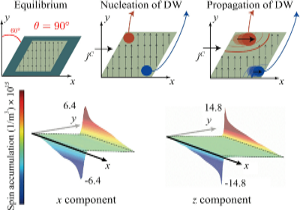A complete set of the generalized drift-diffusion equations for a coupled charge and spin dynamics in ferromagnets in the presence of extrinsic spin-orbit coupling is derived from the quantum kinetic approach, covering major transport phenomena, such as the spin and anomalous Hall effects, spin swapping, spin precession, and relaxation processes.
It is argued that the spin swapping effect in ferromagnets is enhanced due to spin polarization, while the overall spin texture induced by the interplay of spin-orbital and spin precession effects displays a complex spatial dependence that can be exploited to generate torques and nucleate or propagate domain walls in centrosymmetric geometries without the use of external polarizers, as opposed to the conventional understanding of spin-orbit mediated torques.
Spin-orbit torques generated in a single ferromagnetic layer are of great importance in enabling electrical control of the magnetization without the use of external polarizers, and they offer many promising advantages compared to spin-transfer torques, such as high scalability and stability.
Thus, finding novel routes to excite magnetization dynamics by means of spin-orbit torques is essential for realizing high-performance spintronic devices. Recently, a new mechanism referred to as spin swapping, which converts a primary spin current into a secondary spin current with interchanged spin and flow directions was proposed to exist in normal metals and semiconductors in the presence of spin-orbit coupled impurities.
Spintec’s theory group in collaboration with colleagues at KAUST has clarified the nature of the extrinsic spin Hall and spin swapping effects in diffusive ferromagnets, and demonstrated that these effects can offer potential advantages in contrast to noncentrosymmetric magnetic multilayers involving heavy metals. They first derived a set of coupled spin-charge diffusive equations was derived by using the nonequilibrium Green’s function formalism and taking into account scattering off the impurity induced SOC potential. Next, the interplay between spin-orbital and spin precession effects has been investigated in order to demonstrate current-driven manipulation of the magnetization in centrosymmetric magnets. This follows from distorted spin accumulation profiles built up, for instance, in samples with a diamond-shaped geometry shown in figure above giving rise to nonzero local spin-orbit torques.
Spin accumulation profiles (bottom-left and bottom-right panels) as calculated for the diamond-shaped geometry.
The top panels describe the idea of nucleation and propagation of reversed magnetic domains. Red and blue circles correspond to the spin-up and spin-down components of the spin accumulation, respectively; black arrows show the magnetization pointed along the y axis.
Team: Theory and Simulation
Collaboration: KAUST (Saudi Arabia);
Funding: “Emergence et partenariat stratégique” program at the Univ. Grenoble Alpes
Further reading: Spin Hall and Spin Swapping Torques in Diffusive Ferromagnets, Christian Ortiz Pauyac, Mairbek Chshiev, Aurelien Manchon, and Sergey A. Nikolaev, Phys. Rev. Lett. 120, 176802 (2018). DOI: 10.1103/PhysRevLett.120.176802
Contact : mair.chshiev@cea.fr

